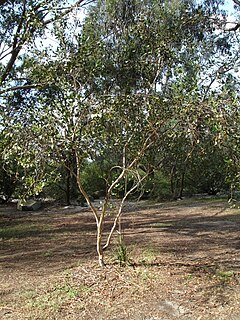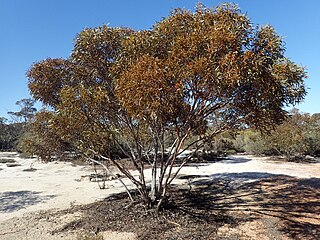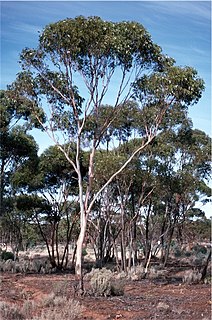
Eucalyptus platypus, also known as moort or maalok, is a species of mallee or marlock that is endemic to the southwest of Western Australia. It has smooth bark, broadly elliptical to more or less round adult leaves, flower buds in groups of nine on a broad, flattened peduncle, usually creamy white flowers and conical, down-turned fruit.

Eucalyptus cornuta, commonly known as yate, is a tree species, sometimes a mallee and is endemic to the southwest of Western Australia. It has rough, fibrous bark on all or most of its trunk, smooth bark above, mostly lance-shaped adult leaves, elongated flower buds in groups of eleven or more, yellowish flowers and cylindrical to cup-shaped fruit. It is widely cultivated and produces one of the hardest and strongest timbers in the world.

Eucalyptus burdettiana, commonly known as Burdett gum or Burdett's mallee, is a species of flowering plant in the family Myrtaceae and is endemic to Western Australia. It is a mallee or shrub with smooth bark, lance-shaped adult leaves, flower buds with an elongated horn-shaped operculum, greenish-yellow flowers and cup-shaped or bell-shaped fruit.
Eucalyptus indurata, commonly known as ironbark or ironbark mallee, is a species of tree or mallee that is endemic to southern Western Australia. It has rough, hard, blackish, furrowed bark on the trunk, smooth whitish bark above, lance-shaped adult leaves, flower buds in groups of seven, white to pale yellow flowers and shortened spherical fruit.

Eucalyptus kessellii, commonly known as Jerdacuttup mallee, is a species of mallee that is endemic to an area along the south coast of Western Australia. It has very hard, rough bark on the trunk of larger specimens, smooth greyish and brownish bark above, lance-shaped to egg-shaped adult leaves, flower buds in groups of three or seven, creamy white flowers and downturned, conical to cup-shaped fruit.

Eucalyptus newbeyi, commonly known as Beaufort Inlet mallee, is a species of mallee that is endemic to a small area on the south coast of Western Australia. It has smooth, mottled bark, narrow leaves, flower buds usually in groups of seven, yellowish green flowers and bell-shaped to conical fruit.

Eucalyptus pileata, commonly known as the capped mallee, is a species of mallee that is native to South Australia and Western Australia. It has smooth greyish bark, narrow lance-shaped adult leaves, flower buds in groups of seven, white flowers and cup-shaped, conical or barrel-shaped fruit.

Eucalyptus platycorys, commonly known as Boorabbin mallee, is a species of mallee, rarely a small tree, that is endemic to Western Australia. It has rough, dark grey, fibrous and flaky bark on the trunk, smooth greyish bark above, lance-shaped adult leaves, flower buds usually in group of three, creamy white flowers and cup-shaped to cylindrical fruit.
Eucalyptus pruiniramis, commonly known as Jingymia gum or midlands gum is a species of mallee or tree that is endemic to a small area of Western Australia. It usually has rough bark on the lower half of the trunk, smooth bark above, dull green, lance-shaped adult leaves, flower buds in groups of between seven and eleven, white flowers and cylindrical to cup-shaped fruit.
Eucalyptus semota, commonly known as marymia mallee, is a species of mallee or small tree that is endemic to a small area in central Western Australia. It has rough, flaky to fibrous bark on the trunk, smooth grey or brown bark above, linear to narrow lance-shaped leaves, flower buds in groups of seven or nine, white flowers and conical to cup-shaped fruit.

Eucalyptus sepulcralis, commonly known as weeping gum or weeping mallee, is a mallee that is endemic to a small area along the southern coast of Western Australia. It has slender stems with smooth bark, narrow elliptical to narrow lance-shaped leaves, flower buds in groups of seven, pale yellow flowers and barrel-shaped to urn-shaped fruit.

Eucalyptus stoatei, commonly known as scarlet pear gum or Stoat's mallee, is a tree that is native to a small area along the south coast of Western Australia.

Eucalyptus conglobata, also known as the cong mallee or Port Lincoln mallee, is a species of eucalypt that is native to the south coast of Western Australia and South Australia. It is a mallee with smooth bark, lance-shaped adult leaves, flower buds in groups of seven, white flowers and clustered hemispherical fruit.

Eucalyptus coronata, commonly known as the crowned mallee, is a species of mallee that is endemic to a small part of the south coast of Western Australia. It has smooth bark on the trunk and branches, lance-shaped to curved adult leaves, flower buds with pronounced ribs, arranged in groups of three in leaf axils, white to cream-coloured or yellow flowers and conical, prominently ribbed fruit.

Eucalyptus corrugata, also known as rough fruited mallee or rib-fruited mallee, is a species of tree or mallee that is endemic to Western Australia. It has rough scaly or fibrous bark on the lower part of its trunk, smooth bark above, glossy, lance-shaped adult leaves, prominently corrugated flower buds arranged in groups of three in leaf axils and ribbed, conical to cup-shaped fruit.

Eucalyptus desmondensis, commonly known as Desmond mallee, is a species of slender mallee that is endemic to a small area in the south-west of Western Australia. It has smooth bark, lance-shaped adult leaves, flower buds in groups of between nine and nineteen, cream-coloured to pale yellow flowers and cup-shaped to barrel-shaped fruit.

Eucalyptus dielsii, commonly known as the cap-fruited mallee or cap-fruited mallet is a species of mallet that is endemic to the south-west of Western Australia. It has smooth bark, lance-shaped adult leaves, flower buds in groups of seven, yellow to yellowish green flowers and cylindrical to hemispherical fruit with a flange near the rim.
Eucalyptus ecostata, commonly known as coastal silver mallee, is a species of mallee that is endemic to the south coast of Western Australia. It has smooth greyish bark, lance-shaped to curved adult leaves, flower buds in groups of between eleven and fifteen, creamy white flowers and more or less hemispherical but flattened fruit.
Eucalyptus proxima, commonly known as nodding mallee or red-flowered mallee, is a species of mallee that is endemic to a small area in the south-west of Western Australia. It has smooth greyish bark, lance-shaped adult leaves, flower buds in groups of seven, red to pink, sometimes yellowish flowers and conical to slightly bell-shaped fruit.
Eucalyptus × stoataptera is a small tree that is endemic to a small area on the south coast of Western Australia. It has a dense crown, smooth bark on the trunk and branches, glossy, oblong leaves, single flower buds in leaf axils, lemon-orange flowers, and fruit that are square in cross-section. It is a natural hybrid between Eucalyptus stoatei and E. tetraptera.

















